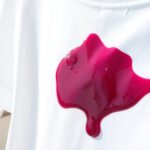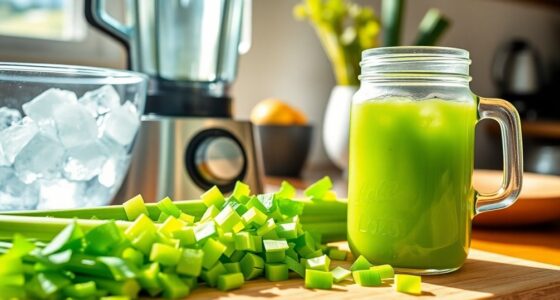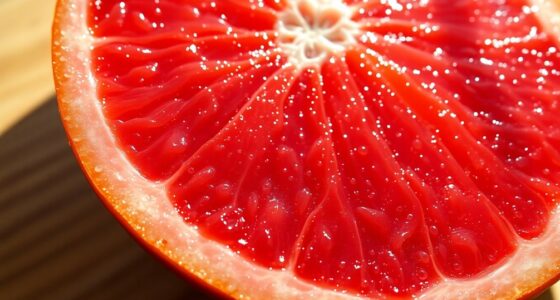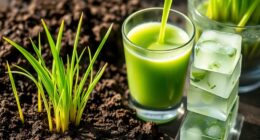To get out grape juice stains from clothing, act fast! Blot the stain with a clean cloth to absorb excess juice, then rinse it under cold water from the back of the fabric. Pre-treat with a stain remover or a mix of dish soap and white vinegar. Wash in the coldest water safe for the fabric and check for any remaining stains before drying. If stains persist, try a hydrogen peroxide and dish soap mix. Discover more tips to tackle tough stains!
Key Takeaways
- Blot excess grape juice with a clean cloth immediately to absorb the stain without rubbing.
- Rinse the stained area under cold running water from the back to dilute the juice.
- Pre-treat the stain with a stain remover spray or a mix of dish soap and white vinegar for 15-30 minutes.
- Wash the garment in the coldest water safe for the fabric with quality laundry detergent.
- For persistent stains, apply a hydrogen peroxide and dish soap mixture before washing again.

Grape juice stains can be a real headache, but if you act quickly, you can often remove them with ease. The first step is to blot the excess grape juice immediately with a clean white cloth or paper towel. You want to absorb as much liquid as possible before it sets into the fabric. Remember, the key is to blot, not rub, as rubbing can push the stain deeper into the fibers.
Next, you should rinse the stained area under cold running water. Always rinse from the back of the fabric so you can dilute the juice and prevent it from penetrating further. This step helps to lift the stain out of the fabric and is crucial in your stain removal process.
After rinsing, take a moment to assess the stain. If it's still visible, you'll need to pre-treat it to improve your chances of a successful removal.
For pre-treating the stain, you have a couple of effective options. You can use a stain remover spray or make a simple solution of dish soap and white vinegar. Apply your chosen pre-treatment directly onto the stain, ensuring it's thoroughly saturated. Allow it to sit for about 15-30 minutes so the solution has enough time to break down the grape juice stain. This waiting period is essential, as it enhances the cleaning power of the solution.
Once you've allowed the pre-treatment to work its magic, it's time to wash the garment. Use the coldest water that's safe for the fabric, along with a quality laundry detergent. It's important to check for any remaining stains before you dry the clothing. If you toss it in the dryer with the stain still present, heat can set the stain, making it nearly impossible to remove later.
If you find that the stain persists even after washing, don't fret. You can tackle tough or dried stains with a mixture of hydrogen peroxide and dish soap. Apply this mixture directly onto the discolored area and let it sit for a few minutes before washing again. This combination is particularly helpful because hydrogen peroxide acts as a gentle bleach, which can lift the discoloration from the fabric without causing damage.
Frequently Asked Questions
What Removes Grape Juice From Clothes?
To remove grape juice from clothes, you'll want to act fast.
Start by blotting the stain with a clean cloth to soak up excess juice. Rinse the area with cold water to dilute it.
Next, pre-treat the stain using a stain remover or a mix of dish soap and white vinegar, letting it sit for 15-30 minutes.
Wash the garment in cold water, checking for any remaining stains before drying.
Does Hydrogen Peroxide Remove Grape Juice Stains?
When life spills grape juice, hydrogen peroxide becomes your knight in shining armor.
Yes, hydrogen peroxide can effectively banish those pesky stains. Mix it with a dash of dish soap and apply it directly to the stain. Let it sit for about 15 minutes before rinsing.
Just remember to test it on a hidden spot first to ensure your fabric remains unscathed. Rinse with cold water, and you're on your way to stain-free triumph!
How to Remove Grape Jelly Stains From Clothes?
To remove grape jelly stains from your clothes, start by scraping off any excess jelly gently with a spoon.
Rinse the stained area under cold water, pushing from the back of the fabric.
Next, pre-treat the stain with a mix of dish soap and white vinegar, letting it sit for 15-30 minutes.
Wash the garment in the hottest safe water with quality detergent, checking for the stain before drying to avoid setting it.
Do You Use Hot or Cold Water for Grape Juice Stains?
When dealing with grape juice stains, you should start with cold water. Hot water can set the stain, making it tougher to remove.
Rinse the stained area from the back with cold water to help push the juice out. After pre-treating the stain, wash the garment in cold water to avoid setting any remaining juice. After washing, inspect the item to ensure the stain is fully removed before drying, as heat from the dryer can set any lingering marks. If the stain persists, you may want to repeat the rinsing and washing process. For those who enjoy working with fresh fruits, learning how to prepare pear juice can be a delightful addition to your kitchen repertoire, providing a refreshing beverage that’s perfect for any occasion.
If the fabric allows, you can use hot water for the final wash to eliminate any traces left.
Conclusion
Removing grape juice stains can feel like trying to erase a permanent marker from a whiteboard, but it's definitely possible with the right approach. Just like a magician pulling a rabbit out of a hat, you can make those stubborn stains disappear! Remember, acting quickly and using the right techniques is key. With a little patience and the right tools, you'll have your clothes looking fresh again in no time. Don't let a spill ruin your day!
Cindy thoroughly researches juicing trends, techniques, and recipes to provide readers with practical advice and inspiration. Her writing style is accessible, engaging, and designed to make complex concepts easy to understand. Cindy’s dedication to promoting the advantages of juicing shines through her work, empowering readers to make positive changes in their lives through the simple act of juicing.

















